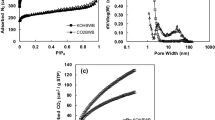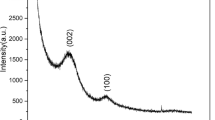Abstract
Infested ash tree residues were carbonized at 600, 700 and 900 °C. The carbonization product—biochar (BC) was investigated as a potential active material for supercapacitor electrodes in its original (o-BC) and activated (a-BC) forms. The electrodes were formed with o-BC or a-BC and a water based composite binder. The correlation between the physical properties of BC and electrochemical properties of these electrodes were carefully investigated in H2SO4 and aqueous LiN(SO2CF3)2 electrolytes. The results obtained from cyclic voltammetry, electrochemical impedance spectrometry and charge/discharge measurements showed approximately a tenfold increase in the capacitance of the electrodes with the a-BC. Further analysis of the BC samples identified functional groups on the carbon surface of the a-BC which could be responsible for such a dramatic increase in the performance of the electrodes. The highest specific capacitances of 470 F g−1 in 0.75 M H2SO4 and 335 F g−1 in 3 M LiN(SO2CF3)2 were achieved. The cycle life of electrodes with a-BC in LiN(SO2CF3)2 electrolyte is stable and shows a very insignificant decrease in capacitive performance after 1500 cycles. These results indicate that the BC derived from infested ash trees is a promising material for use in supercapacitor electrodes.












Similar content being viewed by others
References
Diesel Engine/Locomotive Cranking & Supercapacitors, Electronic Components KEMET charged http://www.kemet.com/Lists/TechnicalArticles/Attachments/124/2013-11%20Diesel%20Engine%20Locomotive%20Cranking%20and%20KEMET%20Supercapacitors.pdf. Accessed 30 July 2014
T. Xue, X. Wang, J.M. Lee, Dual-template synthesis of Co(OH) 2 with mesoporous nanowire structure and its application in supercapacitor. J. Power Sources 201, 382–386 (2012)
J.N. Coleman, U. Khan, W.J. Blau, Y.K. Gun’ko, Small but strong: a review of the mechanical properties of carbon nanotube–polymer composites. Carbon 44, 1624–1652 (2006)
Y. Xie, D. Fu, Supercapacitance of ruthenium oxide deposited on titania and titanium substrates. Mater. Chem. Phys. 122, 23–29 (2010)
Facts About B.C.’s Mountain Pine Beetle’, April 2013 http://www.for.gov.bc.ca/hfp/mountain_pine_beetle/Updated-Beetle-Facts_April2013.pdf. Accessed 21 July 2014
Natural Resources Canada, Mountain pine beetle—http://www.nrcan.gc.ca/forests/insects-diseases/13381. Accessed 28 July 2014
J. Hunt, M. DuPonte, D. Sato, A. Kawabata, The basics of biochar: a natural soil amendment, soil and crop management, Published by the College of Tropical Agriculture and Human Resources (CTAHR) UH–CTAHR SCM-30, (2010)
H.P. Schmidt, Novel Uses of Biochar, USBI Biochar Conference, June 25, 2013
S. Teng, G. Siegel, W. Wang, A. Tiwari, Carbonized wood for supercapacitor electrodes. ECS Solid State Lett. 3(5), 25–28 (2014)
S. Koutcheiko, V. Vorontsov, Activated carbon derived from wood biochar and its application in supercapacitors. J. Biobased Mater. Bioenergy 7, 733–740 (2013)
M. Liu, L. Kong, P. Zhang, Y. Luo, L. Kang, Porous wood carbon monolith for high-performance supercapacitors. Electrochim. Acta 60, 443–448 (2012)
J. Jiang, L. Zhang, X. Wang, N. Holm, K. Rajagopalan, F. Chen et al., Highly ordered macroporous woody biochar with ultra-high carbon content as supercapacitor electrodes. Electrochim. Acta 113, 481–489 (2013)
H. Jin, X. Wang, Z. Gu, J. Polin, Carbon materials from high ash biochar for supercapacitor and improvement of capacitance with HNO3 surface oxidation. J. Power Sources 236, 285–292 (2013)
J. Hong, W. Xiaomin, G. Zhengrong, G. Anderson, K. Muthukumarappan, Distillers dried grains with soluble (DDGS) bio-char based activated carbon for supercapacitors with organic electrolyte tetraethylammonium tetraßuoroborate. J. Environ. Chem. Eng. 2, 1404–1409 (2014)
P. Kalyani, A. Anitha, Biomass carbon and its prospects in electrochemical energy systems. Int. J. Hydrogen Energy 10, 4034–4045 (2013)
L.J. Kennedy, J.J. Vijaya, G. Sekaran, Electrical conductivity study of porous carbons derived from rice husk. Mater. Chem. Phys. 91, 471–476 (2005)
L. Wei, G. Yushin, Nanostructured activated carbons from natural precursors for electrical double layer capacitors. Nano Energy 1, 552–565 (2012)
L. Kouchachvili, N. Maffei, E. Entchev, Novel binding material for supercapacitor electrodes. J. Solid State Electrochem. 18, 2539–2547 (2014)
MSDS Acheson Colloids Company (USA) Distributed by Ladd Research (USA)
T. Randriamanantena, F. Lahatrarazafindramisa, G. Ramanantsizehena, A. Bernes, C. Lacabane, Thermal behaviour of three woods of Madagascar by thermogravimetric analysis in inert atmosphere, 4th high-energy physics international conference 2009, Madagascar
M. Polleto, J. Dettenborn, V. Pistor, M. Zeni, A.J. Zattera, Materials produced from plant biomass. Part 1: evaluation of thermal stability and pyrolysis of wood. Mater. Res. 13, 375–379 (2010)
L.E. Hernandez-Mena, AAB. Pécora, A.L. Beraldo, Slow pyrolysis of bamboo biomass: analysis of biochar properties, CET Chem. Eng. Trans. 37, 115–120 (2014)
M.G. Gronli, G. Varhegyi, C. Di Blasi, Thermogravimetric analysis and devolatilization kinetics of wood. Ind. Eng. Chem. Res. 41, 4201–4208 (2002)
E. Putun, B.B. Uzun, A.E. Putun, Composition of products obtained via fast pyrolysis of olive-oil residue: effect of pyrolysis temperature. J. Anal. Appl. Pyrol. 79, 147–153 (2007)
N. Ali, M. Saleem, M. Kalim, K. Shahzard, A. Chughtai, Thermogravimetric study of Pakistani cotton and maize Stalk using iso-conversional technique. Life Sci. 8, 382–387 (2014)
K. Kim, J. Kim, T. Cho, J. Choi, Influence of pyrolysis temperature on physicochemical properties of biochar obtained from the fast pyrolysis of pitch pine (Pinus rigida). Bioresour. Technol. 118, 158–162 (2012)
B.E. Conway, Electrochemical Supercapacitors (Kluwer Academic/Plenum, New York, 1999)
R. Azargohar, S. Nanda, J. Kozinski, A. Dalai, R. Sutarto, Effects of temperature on the physicochemical characteristics of fast pyrolysis bio-chars derived from Canadian waste biomass. Fuel 125, 90–100 (2014)
L. Wang, X. Li, J. Ma, Q. Wu, X. Duan, Non-activated, N, S-co-doped biochar derived from banana with superior capacitive properties. Sustain. Energy 2, 39–43 (2014)
Acknowledgments
Funding for this work was provided by Transport Canada and is gratefully acknowledged. L.K. would like to thank Dr. Michio Ikura for valuable technical discussions. The authors would also like to thank A. Hall and K. Michaelian for the SEM images and FTIR data.
Author information
Authors and Affiliations
Corresponding author
Rights and permissions
About this article
Cite this article
Kouchachvili, L., Maffei, N. & Entchev, E. Infested ash trees as a carbon source for supercapacitor electrodes. J Porous Mater 22, 979–988 (2015). https://doi.org/10.1007/s10934-015-9972-2
Published:
Issue Date:
DOI: https://doi.org/10.1007/s10934-015-9972-2




